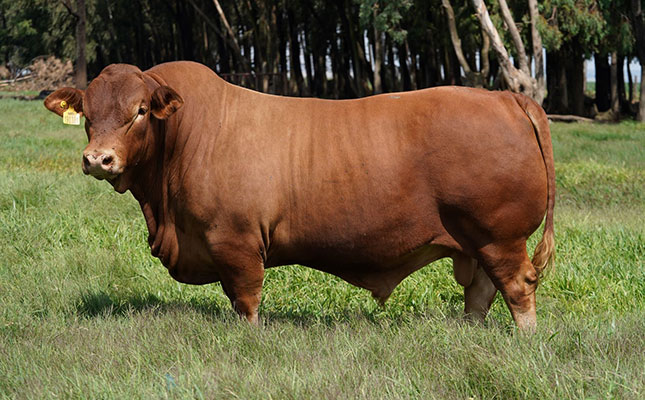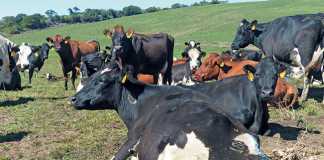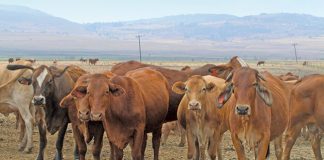
Photo: Supplied
Red cattle breeds often come in for criticism, with many farmers and others in the industry saying there are in fact minimal differences between these breeds. What is your opinion on this, and how does the Beefmaster differ from other beef breeds?
If you’re looking at a breed’s breeding goals, or what it’s supposed to be in order to breed calves economically and produce animals both for herd replacement and the feedlot, then all synthetic breeds are supposed to look more or less alike. The appearance of an animal is influenced by its breeding goals, environment and, of course, its breed composition.
The real distinction is in the animal or breed’s performance, and this is where the Beefmaster breed can be distinguished from all other breeds that are performance-tested by SA Stud Book.
Here, it has been shown that the Beefmaster is the leader in intercalving period (ICP) and cow-to-calf ratio, which is the calf’s percentage of its dam’s weight at weaning. When taking this into account, Beefmaster is, on average, more profitable than other breeds.
Beefmaster also boasts the largest herd per breeder, which shows that the breed performs well in any commercial setting.
Please describe the ideal Beefmaster bull.
It is medium-framed, has a good coat, and has a distinctly masculine appearance, with a strong brow ridge and well-developed neck and shoulders. It should have a comfortable gait as a result of good-sized hooves and strong and correct bone structure. The body should be well-balanced.
Beefmaster’s genetic composition comprises 50% Brahman, 25% Shorthorn and 25% Hereford. With its large Brahman component, the bull is expected to have loose, supple skin and relatively large ears. The sheath should not be too long. Beefmaster bulls are known for their high libido and agility.
A bull must meet the minimum breed standards, and these are strictly enforced.
Could you give us a description of the ideal Beefmaster cow?
She should be functional and efficient, and therefore able to feed, walk and produce optimally. She should have a medium frame and be wedge-shaped when viewed from the side and above.
The Beefmaster cow is expected to have a well-developed udder and genitals, and be early- maturing. As with the bull, she should have the correct hoof and structure and thus be able to walk well.
Good rumen capacity is a must, due to the nature of grazing in South Africa. Nutrient levels here are often lower than those in Europe, for example, and animals must consume larger volumes each day to meet their nutritional requirements.
What is a Beefmaster’s temperament?
Temperament is one of the ‘Six Essentials’, the six traits that Tom Lasater, the founder
of the Beefmaster breed, deemed crucial for selection. The other five are conformation, weight, fertility, milk production and hardiness. Research shows that temperamental animals put on fat or grow more slowly. Such animals will therefore also be less fertile and less reproductive.
Animals with a poor temperament also tend to damage fences and handling facilities, so these are strictly discriminated against.
One should not, however, confuse poor temperament and good maternal qualities. A dam should protect her calf against predators, and some cows instinctively try to protect their calves against anyone trying to mark and weigh them.
Is Beefmaster a good breed of cattle for a subsistence farmer?
The Beefmaster crosses well with all other breeds, including indigenous breeds. In a communal setting, this means that a farmer gains a heavy, marketable calf that can maximise income.
One of Beefmaster SA’s affiliates, Ndumiso Gule of Gule Agri Consulting, carries out a considerable amount of training to assist communal farmers in their efforts to improve their operations. He believes that Beefmaster bulls are ideal for upgrading herds and helping communal farmers to farm more efficiently and develop commercially viable farms.
Beefmaster’s Brahman/ Shorthorn/Hereford composition ensures hardiness, adaptability, good milk production, and excellent growth. These features are crucial for communal farmers, who so often suffer from limited resources.
Which climate best suits the Beefmaster?
Thanks to the composition of the breed and our consistently strict selection for adaptability and hardiness, Beefmaster breeders are found all over South Africa: from the bushveld of northern Limpopo, to the cold eastern Highveld, the Free State, the Eastern Cape, and the dry Northern Cape.
Individual animals also adapt well, even when they’re moved to a different climate. We transported a herd from Koster in North West to Ermelo in Mpumalanga. That’s 400km east, something that’s against the laws of nature! Yet weaning weights and conception rates were unchanged the following season.
What would be an ideal ICP for a Beefmaster calf, and why?
The ideal ICP is, of course, 365 days, because calving would then always take place in the same season. A farmer always tries to work with the seasons and farm in harmony with nature in order to reduce the use of supplements as much as possible. Beefmaster SA’s average ICP is 399 days across 14 665 cows. In reality, few breeds achieve an ICP of under 400 days.
Fertility is always a priority. However, animal diseases such as trichomoniasis and bovine brucellosis can wreak havoc in a herd. What is your breed society doing to keep these diseases under control within the breed?
Venereal diseases can threaten any herd’s fertility and reproduction. All Beefmaster animals marketed are therefore required to have a health certificate confirming that the animals are free of these venereal diseases.
Does the Beefmaster perform better on veld or in the feedlot?
It performs excellently in the veld under extensive conditions, yet it also grows very
well in a feedlot. In addition, it has good disease resistance, which helps to make it a highly sought-after breed. Feedlots pay a premium for Beefmaster calves. Having a cow that is hardy, fertile and functional, and bears calves that are in demand by feedlots, helps to make cattle farming far easier.
Foot-and-mouth disease (FMD)has wreaked havoc in the livestock industry. What is Beefmaster SA doing to alleviate the problem for its breeders?
FMD can be spread by humans, animals and vehicles, and all livestock owners are exposed to the danger when there are breaks in the biosecurity system. It is worrying that the state is handling the current FMD problem so poorly, and we are very concerned that this will harm meat prices.
In an effort to mitigate the situation, the society regularly shares information with its members on how to manage biosecurity.
In general, how can farmers ensure that their herds don’t fall victim to FMD or any other animal disease?
By limiting access to their farms. Producers should also work with animals in a responsible manner and ensure that their neighbours and workers are aware of the dangers of FMD.
Email Gerrie Jansen van Rensburg at [email protected].











